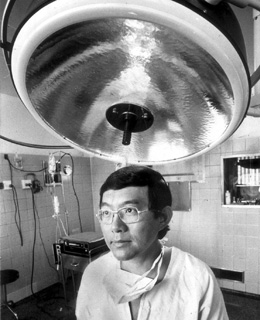
Heart surgeon Doctor Victor Chang at Saint Vincent's Hospital in 1984
In 1999, Australians taking part in the People's Choice Awards, a kind of pop-culture popularity contest, had a choice to make. The four finalists for Australian of the Century were Dawn Fraser, a beloved swimmer from the 1950s and '60s, Donald Bradman, the greatest cricketer ever to pick up a bat, Fred Hollows, an eye doctor whose techniques had helped a million or so people see again, and Victor Chang, a Chinese-born Australian heart surgeon. It might surprise non-Australians used to seeing the country as a bastion of old-fashioned white values that the nation's television viewers opted for Chang.
Australians loved Chang, a softly spoken Shanghai-born doctor who collected heart-surgery breakthroughs and fast cars with equal passion. The son of Australian-born Chinese parents, he arrived in 1953 to finish his high-school studies. By the time he was murdered in a botched robbery in morning traffic on a July day in 1991, he had become one of the country's great immigrant success stories, and, at that time at least, a rare Asian face in Australian public life. Lauded for re-establishing heart transplant surgery in Australia, after the field had languished due to the risks and costs, he founded the highly successful National Heart Transplant Program in 1984, created an artificial heart valve, taught his skills to doctors from around the world, and was working on an artificial circulatory system when he was killed. "When no one else was putting their hand up, he was saying, 'Yes, we want to do [heart transplants],'" says Dr. Phillip Spratt, director of heart and lung surgery and transplantation at St. Vincent's Hospital, where Chang worked.
Chang was part of a larger tale. One of the defining narratives in 1980s Australia was the beginning of large-scale Asian immigration. Modern Australia has always been an immigrant nation; since 1945, 6.8 million people have arrived from the four corners of the globe. For much of that time, though, immigrants were overwhelmingly from Europe. The Immigration Restriction Act of 1901 established what became known as the White Australia Policy, which effectively shut out Asians and other non-Europeans. As Australia's first Immigration Minister, Arthur Calwell, said in 1947: "We have 25 years at most to populate this country before the yellow races are down on us."
The end of that racist policy in the late 1960s and early '70s saw nonwhite immigration edge up. Tens of thousands of Vietnamese and Cambodian refugees arrived in the late 1970s and Asian immigration expanded even faster in the 1980s. In the mid-1970s just one Asian country, India, made the top 10 source countries for immigrants to Australia. A decade on, China, Hong Kong, Malaysia, the Philippines, Sri Lanka and Vietnam joined it on the list. The Labor Party, which held power for most of the decade, saw immigration as a way to make Australia as dynamic as places like Singapore and Hong Kong. It was "the only tool readily at hand to challenge our complacency, smugness and parochialism," as one immigration official argued.
Unsurprisingly, the new immigrants were met by some anti-Asian sentiment, often focused around ethnic crime, gangs and joblessness. A fierce national debate was sparked in 1984 when the renowned University of Melbourne historian and academic Geoffrey Blainey decried what he believed was a disproportionately high level of Asian settlers. In 1988, then opposition leader (later Prime Minister) John Howard sparked further debate when he called for the rate of Asian immigration to be slowed for the sake of social cohesion.
Twenty years on, Australia is a different nation. Chinese languages rank among the most spoken in the country. A quarter of all Australians are foreign-born, compared to just 11% of Americans, and 6% of all Australians consider themselves ethnically Asian. Victor Chang would have been amazed by this rapid reinvention. But in his wake, Asian immigration has had a major impact in business, economics, politics, the arts, science and food. "Vietnamese is the new meat pie," says Andrew Jakubowicz, professor of sociology at the University of Technology, Sydney. Prominent Asian Australians include the Federal Minister for Climate Change, Penny Wong; John So, the former lord mayor of Melbourne; Henry Tsang, the former deputy lord mayor of Sydney; fashion designers Akira Isogawa, Jenny Kee and Lisa Ho; chefs Kylie Kwong and Tim Pak Poy; filmmaker and 2005 Young Australian of the Year Khoa Do; comedians Lawrence Leung and Anh Do; neurosurgeon Charles Teo; violinist Susie Park and artist Shen Jiawei.
Australia's Asian influx is reshaping the look of the country. A report this year on mixed-race marriages by Australian National University and Monash University academics found a striking rise in intermarriage between third-generation Asian Australians and white Australians. Their growing number of mixed-race children are the most visible symbols of a new country.
The nation, however, continues to grapple with its cultural identity. Australia is "caught between geography and history, and it continues to be uncomfortable," says Professor Jakubowicz. "We are [no longer] I think, a forlorn outpost of empire, but we are not either an Asian-Pacific nation." Yet even that judgment is changing. Australia's cities have long boasted statues of British monarchs and English explorers. Now, a bronze statue of Chang, dressed in surgical scrubs and clasping a stethoscope, stands sentinel in front of the new $73 million building that houses the Victor Chang Cardiac Research Institute in Sydney. From its plinth, the statue smiles serenely as nuns, office workers and doctors bustle by, scurrying down streets framed by huge industrial cranes and countless Thai restaurants.
Verghis is a Sydney-based freelance journalist and the daughter of south Indian migrants from Malaysia